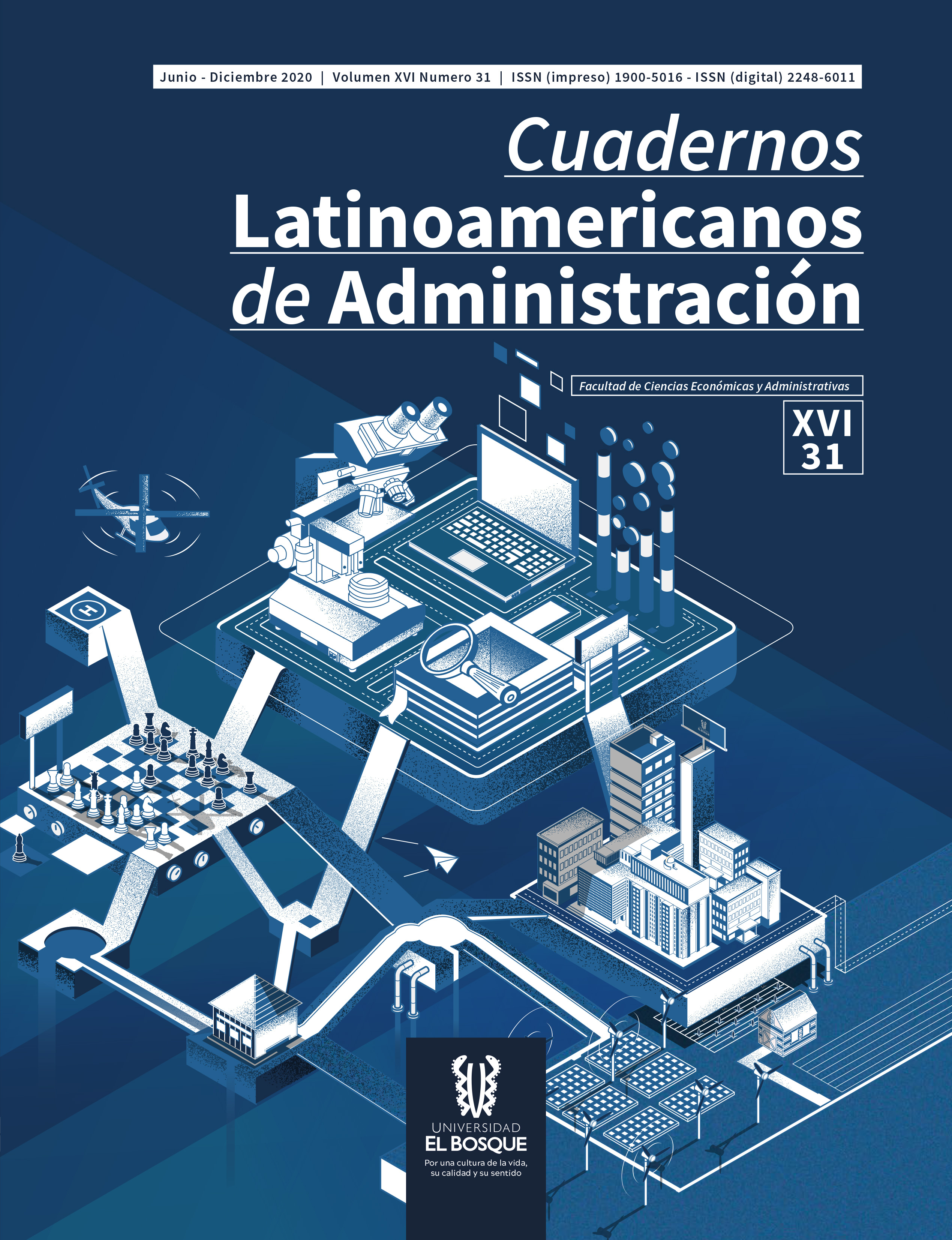La revolución de QUEST Cambio de estrategia como sinónimo de éxito
DOI:
https://doi.org/10.18270/cuaderlam.v16i31.3244Palavras-chave:
Posicionamiento, mercado, comportamiento del consumidor, estrategiaResumo
Una estrategia de mercadeo llevada a cabo eficientemente por las empresas, es un importante componente que agrega valor a su ventaja competitiva. Este estudio de caso analiza una empresa colombiana que ha desarrollado la estrategia de forma exitosa, permitiéndole posicionarse y conquistar nuevos segmentos del mercado en Colombia. Primero, se introduce una revisión de la literatura sobre posicionamiento de marca, fidelización del cliente y mercadeo experiencial. Luego, se desarrolla el estudio de caso basándose en entrevistas en profundidad a personas claves de la empresa. A partir de dichas entrevistas se obtuvo información acerca de cómo ha sido la planeación y la ejecución de la estrategia y sus resultados. Se concluye que el plan realizado por la empresa fue eficiente y exitoso puesto que le permitió cumplir con sus objetivos de posicionamiento de mercado.
Downloads
Referências
Allen, J., Reichheld, F., & Hamilton, B. (2005). “Tuning into the Voice of your Consumer”. Harvard Management Update, 10(10), 3-5.
Anderson, K., & Kerr, C. (2002). Customer Relationship Management. New York: McGrawHill.
Barquero, J. D. (2007). Marketing de Clientes. Quién se ha llevado mi cliente? McGraw-Hill Interamericana de España S.L.
Barrios, M. (2012). Marketing de la Experiencia: principales conceptos y características. Palermo Business Review, 67-89.
Bourgeois, L., & Eisenhardt, K. (1988). Strategic decision process in high velocity enviroment: Four cases in the microcomputer industry. Management Science , 34: 816-835.
Brakus, J., Josko, Schmitt, B., & Zarantonello, L. (2009). «Brand Experience: What Is It? How Is It Measured? Does It Affect Loyalty? Journal of Marketing, 73(3), 52-68.
Carbone, L., & Haeckel, S. H. (1994). “Engineering Customer Experiences”. Marketing Management, 3(3), 8-19.
Crotty, M. (1998). The Foundations of Social Research. St Leonards, NSW: Allen & Unwin.
DeNora, T. (1986). How is extra-musical meaning possible? Music as a place and space for “work”. Sociological Theory n° 4, 84-94.
El País. (2017). Listados De Empresas. Obtenido de www.elpais.com.co: https://www.elpais.com.co/500-empresas/listado
Fernández, E., & Delgado, M. (2010). Marcas De Experiencia: Marcando La Diferencia. Obtenido de www.icesi.edu.co: https://www.icesi.edu.co/revistas/index.php/estudios_gerenciales/article/view/1118/pdf
Gentile, C., Spiller, N., & Noci, G. (2007). «How to Sustain the Customer Experience: An Overview of Experience Components That Co-Create Value with the Customer». European Management Journal, 25(5), 395-410.
Gestor comercial y de crédito. (2019). Base de datos Gestor comercial y de crédito. Obtenido de Universidad Icesi: http://nebulosa.icesi.edu.co:2337/universidades/CredPrincipal.aspx
Gumperz, J. (1977). Sociocultural knowledge in conversational inference. En P. Cole, & J. Morgan, Linguistics and Anthropology. Georgetown: Georgetown University Press.
Henao, J. (2019). Entrevista en profundidad al Director Comercial. Cali: QUEST.
Hirschman, E., & Holbrook, M. (1982). Hedonic consumption: Emerging concepts, methods and propositions. Journal of Marketing 46 (Summer), 92 - 101.
Hoch, S., & Ha, Y. (1986). Consumer learning: Advertising and the ambiguity of product experience. The Journal of Consumer Research, 13, 221-233.
Hoeffler, S., & Keller, K. (2003). The marketing advantages of strong brands. Journal of Brand Management, 10, 421-445.
Holbrook, M. B. (2000). The millen-nial consumer in the texts of our times: Experience and entertain-ment. Journal of Macromarketing, 20(2), 178-192.
Holbrook, M. B., & Schindler, R. M. (2003). “Nostalgic bonding: Exploring the role of nostalgia in the consumption experience”. Journal of Consumer Behaviour, 3(2), 107-127.
Keller, K. (1993). Conceptualizing, measuring, and managing customer-based brand equity. Journal of Marketing, 57, 1-22.
Kerin, R., Hartley, S., & Rudelius, W. (2014). Marketing (11 ed.). USA: McGrawHill.
Krishna, A. (2010). Sensory marketing: Research on the sensuality of products. New York: Routledge.
Manfredi, L., Cabanelas, P., González-Sánchez, J., & Lampón, J. (2019). Multimarket competition and innovation in industrial markets: Spain and Colombia in comparative perspective. Journal of Business & Industrial Marketing, Vol. 35 (3) pg. 457-469.
Masud, M. (2018). An Examination of Case Studies in Management Research: A Paradigmatic Bridge. International Journal of Social Science Studies. RedFame publishing, vol. 6 (3), pages 9-19.
Masud, M. (2018). An Examination of Case Studies in Management Research: A Paradigmatic Bridge. International Journal of social Science Studies, Redfame publishing, vol. 6(3), pages 9-19.
Mingers, J. (1997). Towards Critical Pluralism. Multimethodology: Towards Theory and Practice for Mixing and Matching Methodologies, 407 - 440.
Moliner- Velázquez, B., Fuentes- Blasco, M., Servera- Francés, D., & Gil- Saura, I. (2019). From retail innovation and image to loyalty: moderating effects of product type. Serv Bus, 13, 199- 224.
Morrin, M., & Ratneshwar, S. (2003). Does it make sense to use scents to enhance brand memory? Journal of Marketing Research, 40(10), 10-25.
Oliver, R. (1999). Whence consumer loyalty? Journal of Marketing, 63, 33-44.
QUEST. (2018). Documento de inducción . Cali: Departamento de Gestión Humana.
Rieunier, S. (2002). Le marketing sensoriel du point de vente.
Rodriguez, S. (2016). Visual Marketing: Cuando una imagen vale más que 140 carácteres. Harvard Deusto Marketing y Ventas, 135, 29.
Yin, R. K. (1984). Case Study Research: Design and Methods. Beverly Hills, Calif: Sage Publications.
Yin, R. K. (2003). Applications of Case Study Research (2nd ed.); Case Study Research: Design and Methods (3rd ed.). Thousand Oaks, CA: Sage.
Yin, R. K. (2009). Case Study Research: Design and Methods (4th ed.). Thousand Oaks CA: Sage.
Publicado
Como Citar
Edição
Seção
Licença
Copyright (c) 2021 Cuadernos Latinoamericanos de Administración

Este trabalho está licenciado sob uma licença Creative Commons Attribution-NonCommercial-ShareAlike 4.0 International License.
Los autores cuando envían sus artículos para su evaluación certifican originalidad y transfieren los derechos de propiedad patrimonial a la RevistaCuadernos Latinoamericanos de Administración, de la Universidad El Bosque, para su difusión en forma impresa y/o electrónica. Pero la evidencia científica, la originalidad, el contenido de los documentos son de responsabilidad exclusiva y única de los autores.

| Métricas do artigo | |
|---|---|
| Vistas abstratas | |
| Visualizações da cozinha | |
| Visualizações de PDF | |
| Visualizações em HTML | |
| Outras visualizações | |












